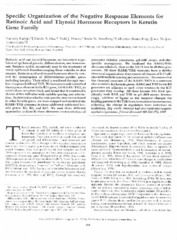Prikaz osnovnih podataka o dokumentu
Specific organization of the negative response elements for retinoic acid and thyroid hormone receptors in keratin gene family
| dc.creator | Radoja, N | |
| dc.creator | Diaz, DV | |
| dc.creator | Minars, TJ | |
| dc.creator | Freedberg, IM | |
| dc.creator | Blumenberg, M | |
| dc.creator | Tomić-Canić, Marjana | |
| dc.date.accessioned | 2018-03-01T18:22:07Z | |
| dc.date.available | 2018-03-01T18:22:07Z | |
| dc.date.issued | 1997 | |
| dc.identifier.issn | 0022-202X | |
| dc.identifier.uri | https://vinar.vin.bg.ac.rs/handle/123456789/2089 | |
| dc.description.abstract | Retinoic acid and thyroid hormone are important regulators of epidermal growth, differentiation, and homeostasis, Retinoic acid is extensively used in the treatment of many epidermal disorders ranging from wrinkles to skin cancers. Retinoic acid and thyroid hormone directly control the transcription of differentiation-specific genes including keratins. Their effect is mediated through nuclear receptors RAR and T3R. We have previously identified the response element in the K14 gene, K14RARE/TRE, to which these receptors bind, and found that it consists of a cluster of five half-sites with variable spacing and orientation. To determine whether this specific structure is found in other keratin genes, we have mapped and analyzed the RARE/TRE elements in three additional epidermal keratin genes: K5, K6, and K17. We used three different approaches to identify these elements: co-transfection of promoter deletion constructs, gel-shift assays, and site-specific mutagenesis. We localized the RARE/TRE elements relatively close to the TATA box in all three promoters. All three RARE/TRE elements have a similar structural organization: they consist of clusters of 3-6 half-sites with variable spacing and orientation. This means that the clustered structure of the RARE/TREs is a common characteristic for keratin genes. RARE and TRE in the K5 promoter are adjacent to each other whereas in the K17 promoter they overlap. All three keratin REs bind specifically both RAR and T3R in gel-shift assays. Interestingly, addition of ligand to the receptor changes the binding pattern of the T3R from homodimer to monomer, reflecting the change in regulation from induction to inhibition. | en |
| dc.rights | openAccess | en |
| dc.rights.uri | https://creativecommons.org/licenses/by-nc-nd/4.0/ | |
| dc.source | Journal of Investigative Dermatology | en |
| dc.subject | clustered half-sites | en |
| dc.subject | epidermis | en |
| dc.subject | negative regulation | en |
| dc.subject | promoters | en |
| dc.title | Specific organization of the negative response elements for retinoic acid and thyroid hormone receptors in keratin gene family | en |
| dc.type | article | en |
| dc.rights.license | BY-NC-ND | |
| dcterms.abstract | Диаз, ДВ; Минарс, ТЈ; Фреедберг, ИМ; ТомицЦаниц, М; Радоја, Н; Блуменберг, М; | |
| dc.citation.volume | 109 | |
| dc.citation.issue | 4 | |
| dc.citation.spage | 566 | |
| dc.citation.epage | 572 | |
| dc.identifier.wos | A1997XY21700012 | |
| dc.identifier.doi | 10.1111/1523-1747.ep12337483 | |
| dc.identifier.pmid | 9326392 | |
| dc.type.version | publishedVersion | |
| dc.identifier.scopus | 2-s2.0-0030773884 | |
| dc.identifier.fulltext | https://vinar.vin.bg.ac.rs//bitstream/id/4799/PIIS0022202X1543026X.pdf |

